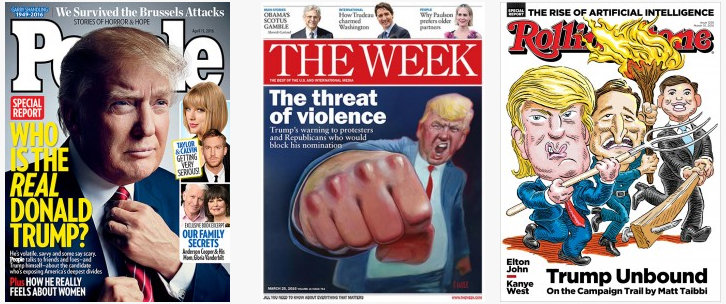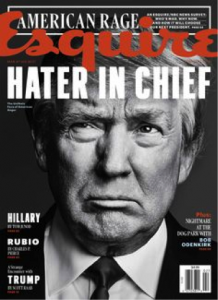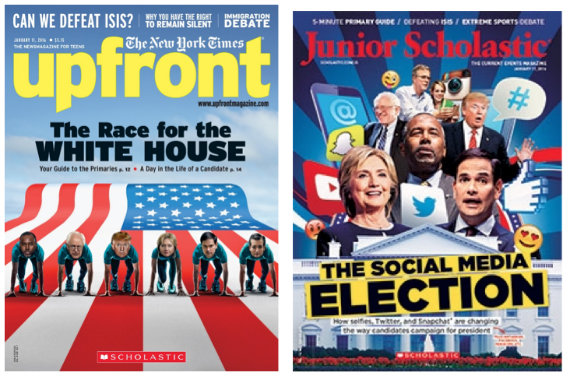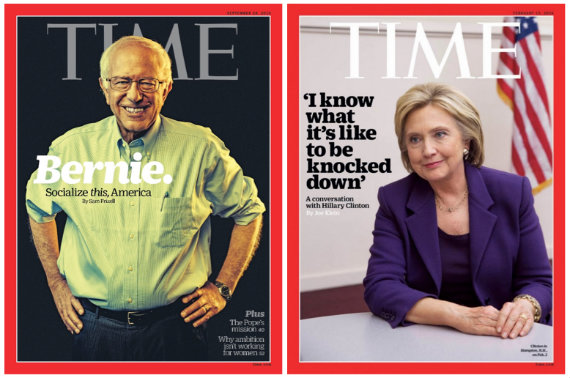SCROLL DOWN TO READ THE POST
On magazine covers and media literacy
Whether they are composed of photographs or illustrations, magazine covers are one of many examples of media offering candidates free coverage. They are also carefully constructed media messages ripe for closer reading and deconstruction to further our students’ digital, visual and political literacies.
In his recent article in MiddleWeb, media literacy expert and consultant Frank W. Baker shares an idea just perfect for school library inquiry across grade levels.
He suggests we work with learners asks learners to dec onstruct candidates’ portrayals on magazine covers.
onstruct candidates’ portrayals on magazine covers.
When a presidential candidate appears on a magazine cover, it may be the culmination of months of negotiation between the news magazine and the candidate. Candidates don’t have final control over how they will be portrayed on the cover. In fact, some cover images may not be complimentary to a candidate . . . We might remind students that each cover started out blank–an editorial team working with a graphic designer collaborated to decide what goes on the cover. They must also consider what will attract the reader and sell.
 To model cover discussion, Baker presents Esquire’s cover of Donald Trump, comparing it to two recent Time covers of Sanders and Clinton:
To model cover discussion, Baker presents Esquire’s cover of Donald Trump, comparing it to two recent Time covers of Sanders and Clinton:
Do you think the image [of Trump] or the words compliment the candidate? Notice the candidate’s expression – what adjective would you use to describe it? Might this cover reveal any bias on the part of the magazine’s owners or publishers? If so, what makes it biased?
Now consider, TIME magazine’s recent cover images of Democrats Hillary Clinton and Bernie Sanders:
Here’s some brief advice on how to get started and what to notice. Look at the lighting on Senator Sanders: can you tell that it’s warm. Notice also the headline: it does not use his last name. Notice also his expression and his body language.
Now consider how TIME chose to portray former Secretary of State Hillary Clinton. She is seated, as opposed to Senator Sanders, who is standing. Why might that be? On first read, did you notice the American flag in the upper right hand corner? Instead of a large font headline (like Bernie in white letters) they’ve used a quote and it’s in black. Why do you think TIME used that quote on the cover? What previous time(s) do you think she is referring to in the quote?
What do you notice about Mrs. Clinton’s body language and expression? Would your students describe this image as warming and welcoming? While Bernie is smiling and looking at “us,” she is looking off camera. Who might she be looking at?

Baker also points to examples to use from our K12 publishers.
He notes that New York Times Upfront’s headline “The Race for The White House” makes it clear which sport is represented and the illustration supports the headline. (For a long time, much of politics has been compared to sports, with the phrase “horse race” still very popular with broadcasters and journalists.)
ADVERTISEMENT
ADVERTISEMENT
Junior Scholastic’s montage cover amplifies the role of social media in the election process. He asks: Can your students identify the candidates (by name) as well as each of the symbols on this cover?
The article, “Use Political Covers to Teach Media Literacy,” proposes that students research and construct their own covers as a creative, group activity demonstrating their understanding of visual literacy.
Baker recommends Secrets of Magazine Cover Design and the Center for Media Literacy’s webpage to help students better understand how to deconstruct visual media messages.
Check out Frank Baker’s website website for many of examples of cover images, for a list of downloadable questions, and for far more inspiration on teaching media literate citizens.
Filed under: information fluency, information literacy, magazines, media, media literacy
About Joyce Valenza
Joyce is an Assistant Professor of Teaching at Rutgers University School of Information and Communication, a technology writer, speaker, blogger and learner. Follow her on Twitter: @joycevalenza
ADVERTISEMENT
SLJ Blog Network
Name That LEGO Book Cover! (#65)
Review of the Day: This is Orange by Rachel Poliquin, ill. Julie Morstad
Betty & Veronica: Summer Fun in the Sun | Preview
Heavy Medal Suggestions: 73 Titles and Counting
Like This, Try That: K-Pop Demon Hunters
The Classroom Bookshelf is Moving
ADVERTISEMENT
ADVERTISEMENT








